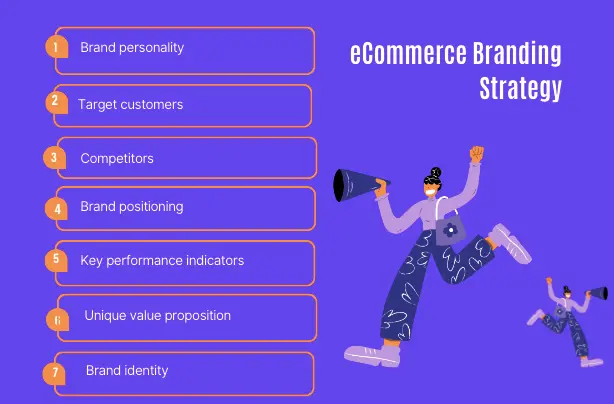How to Build an eCommerce Branding [10 Success Ways]

As the digital marketplace continues to evolve, crafting a strong eCommerce brand has become a strategic imperative for businesses aiming to stand out amidst the competition.
This article explores essential strategies and ten proven ways to build successful eCommerce branding. From defining a unique brand identity to leveraging the power of social media and customer engagement, each approach is tailored to help you create a lasting and positive online presence.
What Is eCommerce Branding?

eCommerce branding is the art and science of creating a distinct and memorable identity for an online business. It goes beyond just a logo or product offerings; it encapsulates the overall perception, values, and personality of the brand.
In the digital realm, where competition is fierce, effective eCommerce branding sets a company apart, fostering customer trust and loyalty. It involves crafting a cohesive visual language, communicating a gripping brand story, and continuously providing satisfied customers.
Ultimately, eCommerce branding is a strategic approach that enhances recognition, builds credibility, and establishes a lasting connection between a brand and its audience in the online marketplace.
The Importance of eCommerce Branding
In the ever-expanding landscape of online commerce, the significance of eCommerce branding cannot be overstated.
ECommerce Branding Builds Trust.

eCommerce branding serves as a foundation for building trust. In a digital realm marked by countless choices, a well-crafted brand establishes credibility, fostering consumer confidence and loyalty.
ECommerce Branding Captures Market Share (and Sales).
Effective eCommerce branding is key in capturing market share and driving sales. A distinct brand identity sets a business apart from competitors, attracting a larger share of the market and, consequently, influencing purchasing decisions. This differentiation is crucial in a crowded online marketplace.
ECommerce Branding Increases Sales.

The impact of eCommerce branding directly translates into increased sales. A strong brand draws in new customers and encourages repeat business, as consumers gravitate towards familiar and trusted entities.
Thus, eCommerce branding emerges as a strategic tool that builds trust and wields the power to shape market dynamics and drive sustained business growth in the digital realm.
7 Things to Consider When Making eCommerce Branding Strategy
Branding helps run your eCommerce business in a specific direction rather than haphazardly. It inspires all parties involved to work toward a common goal. Thus, a branding strategy is integral to eCommerce success, and a good one could hit the jackpot.

Apart from the business, many things play a role in creating a brand. Your eCommerce branding strategy should focus on several things, including:
- Brand personality
- Target customers
- Competitors
- Brand positioning
- Key performance indicators
- Unique value proposition
- Brand identity
How to build an eCommerce Brand Strategy?
In the competitive realm of eCommerce, establishing a robust brand strategy is not just a choice; it's essential for long-term success and progress. A well-defined brand strategy goes beyond product listings, delving into the intricacies of customer perception and engagement.

Here are 10 ways to build a compelling eCommerce brand strategy:
1. Identify Your Target Market
Understanding your audience is paramount. Conduct market research to identify and profile your target customers. Recognize their preferences, behaviors, and needs to tailor your brand strategy effectively.
2. Utter Your Mission Clearly
Clearly articulate your brand's mission. Define the purpose and values that set your eCommerce business apart. A concise and compelling mission statement serves as a guiding force for your brand strategy.
3. Create a Captivating Logo & Name
Craft a visually striking logo and choose a memorable name. These elements are the face of your brand and serve as instant identifiers. Ensure they fit the tone of your business and appeal to your target audience.
4. Tell the Brand's Story
Narrate a captivating brand story that connects with your audience emotionally. Share your journey, values, and milestones.Your brand gains dimension and becomes more memorable and relatable when it has a fascinating story.
5. Be Honest With Your Policies
Transparency is critical to building trust. Communicate your business policies, including shipping, returns, and customer service. Honest and straightforward policies foster trust and credibility among your customers.
6. Focus on Product Quality
Superior product quality is a cornerstone of a strong brand. Consistently delivering high-quality products satisfies customers, builds a positive brand image, and encourages repeat business.
7. Incorporate the Content Strategy
Brand authority in your niche is established through educational content. Develop a content strategy that includes blog posts, guides, and videos to educate your audience. Valuable content not only engages customers but also boosts your brand's credibility.
8. Meet Customers With Email & SMS Marketing
Engage with your audience through targeted email and SMS marketing. Build and segment your email list, sending personalized content, promotions, and updates. Utilize SMS marketing for timely and concise communication.
9. Don't Ignore Influencer Marketing
Leverage the influence of individuals who align with your brand values. Partner with influencers in your industry to reach a wider audience authentically. Influencer marketing can enhance brand visibility and credibility.
10. Be a Part of Something Bigger
Show that your company is committed to something more than just making money by aligning your brand with social or environmental problems. Being socially responsible resonates with conscious consumers and contributes to a positive brand image.
By understanding your audience, communicating a clear mission, and implementing effective marketing tactics, you can build a brand that resonates with customers, fosters trust, and stands the test of time in the competitive world of online commerce.
ECommerce Branding: FAQs
What makes a good eCommerce brand?
A good eCommerce brand is characterized by a strong, memorable identity that resonates with the target audience. It involves a clear mission, visually appealing branding elements, and a commitment to quality, trust, and customer satisfaction.
What are the four types of eCommerce?
The four main types of eCommerce are Business to Consumer (B2C), Business to Business (B2B), Consumer to Consumer (C2C), and Consumer to Business (C2B).
Which is the most popular example of eCommerce?
Amazon is one of the most popular examples of eCommerce, exemplifying the success of the Business to Consumer (B2C) model with its vast online marketplace.
Final Thoughts
ECommerce branding is a dynamic journey that requires dedication, creativity, and strategic thinking. By implementing the ten essential strategies outlined, businesses can cultivate a distinctive and enduring brand presence in the digital realm. The path to eCommerce branding success is multifaceted, from understanding target markets to fostering transparent policies and embracing innovative marketing approaches.
As the online landscape continues to evolve, embracing these strategies will not only differentiate a brand from the competition but also forge lasting connections with customers, driving sustained growth and prosperity in the ever-expanding world of eCommerce.


